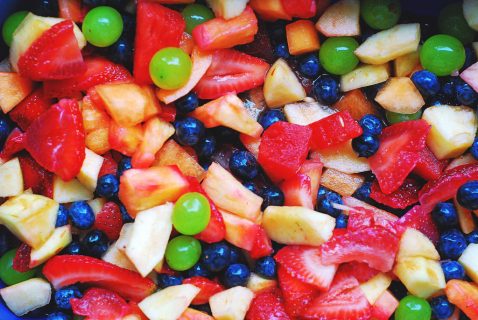
Fruit has become an unfortunate and unnecessary casualty of the war on sugar.
Recently, teen patients of mine have stopped eating fruit. Media outlets (and, in their wake, parents) have latched on to sugar-free and low-carb diets as the newest healthy-eating trend. Popular #fitspo Instagram stars often follow low-carb, high-protein diets in order to shed fat and build muscle. Teens know that fruits have sugar, so many cut them out of their diet in an effort to lose a few pounds. Unfortunately, this means that many young people are missing out on the amazing health benefits of fruit—and for no reason! Unless you are diabetic or have another disease specifically affected by blood sugar, the sugar in fruit will not harm your health. This false belief is based on the idea that all sugar is equally bad for you, which is just not true.
Why is sugar in fruit ok, but sugar in soda bad for me?
Added sugar (which can be found in iced tea, soda, sweets, pastries, breakfast cereals, fruit drinks, and even less obvious foods such as flavored yogurts and peanut butter) certainly deserves its rising reputation as Most Evil Food Ingredient. The average American eats 22 teaspoons of added sugar in a day—that’s 350 calories of empty sugar with no nutritional benefit. Because this sugar is added to food and drinks that are low in fiber, your body absorbs it quickly into the bloodstream. Fiber is a nutrient found in fruit, vegetables, beans, and whole grains that slows down digestion and helps you feel full longer. It also slows down the absorption of sugar. So when you eat added sugar, without this fiber, your blood sugar spikes, leading to energy crashes, weight gain, and more serious health issues like heart disease and Type II diabetes.
Sugar in fruit, vegetables, milk and other natural, whole foods does not have these negative effects. Eating lots of different fruit is actually associated with lower body weights and lower risk for obesity-associated diseases.
This is because naturally found sugar is locked inside cell walls which your body has to break down before it can get at the sugar. Therefore, sugar is released into your blood stream more slowly, creating a sugar “slope” instead of a spike. This means that a piece of fruit is a great choice for an afternoon snack when you need an energy boost! Fruit is packed with vitamins, minerals and antioxidants that your body needs to flourish. Eating a variety of different-colored fruits ensures that you get all of these nutritional benefits that boost your immune system, memory, and heart health.
So what’s the deal with juice?
Despite the popularity of juice “cleanses,” it is actually much healthier to eat fruit whole. Juicing fruit breaks down or removes its fiber, which means the sugar in juice will enter your bloodstream much quicker than the sugar in a piece of fiber-rich fruit. This causes that blood sugar spike. If you do have a juice craving, make sure it’s 100% juice with no sugar added. Toss whole fruit in the juicer, rather than squeezing the juice out, to keep some of that healthy fiber in your drink. If you can, include vegetables in your juice to minimize the sugar spike. Smoothies are another sweet option because they contain more fiber than juice. If you just have to satisfy that juice craving, keep it to one cup per day.
How can I avoid added sugar?
Most added sugar comes from pre-packaged and processed foods. Avoid foods where sugar is one of the first ingredients on the nutrition label—this means there is lots of it. Keep in mind that processed sugars have many different names, such as high-fructose corn syrup, sucrose, dextrose, fruit nectar and more. Here’s a fairly comprehensive list to help. Figuring out how much added sugar is in food can be tricky because companies will include several varieties of sugar on their ingredient list so no single type ends up very high. The FDA’s new food nutrition labels will include added sugar, so keeping an eye out for it will soon be much easier. Few people think in terms of grams, so remember: four grams of sugar is one teaspoon.
The easiest way to avoid added sugar is to eat whole, unprocessed foods with a short ingredient list. These include fresh fruits and vegetables, whole grain cereals like oatmeal, and sugar-free drinks. They may sometimes take longer to make or be harder to find than processed food, but putting in the extra effort will go a long way for your health. If you can’t find cheap, fresh fruit, unsweetened dried fruit is a decent option. However, avoid the sweetened kind, which has (you guessed it) added sugar. Even if you can’t eat whole foods all of the time, just replacing a soda with water or unsweetened tea (that means no Arizona!) can make a big difference.
Tomi Akanbi, MS, RD is the Clinical Nutrition Coordinator at the Mount Sinai Adolescent Health Center. She holds a Master’s degree in Nutrition and Public Health from Columbia University, as well as a BA in Comparative Human Development from the University of Chicago. Tomi is passionate about improving our relationship with food and breaking down the barriers that prevent all New Yorkers from having access to affordable, nutritious food. She understands the challenges of maintaining a healthy lifestyle, but believes that balanced eating, exercise, and overall wellness can be enjoyable and attainable for all.
The Mount Sinai Adolescent Health Center is located in New York City. It provides comprehensive, confidential, judgment free health care at no charge to over 10,000 young people every year. This column is not intended to provide medical advice, professional diagnosis, opinion, treatment or services to you or to any other individual, only general information for education purposes only.


